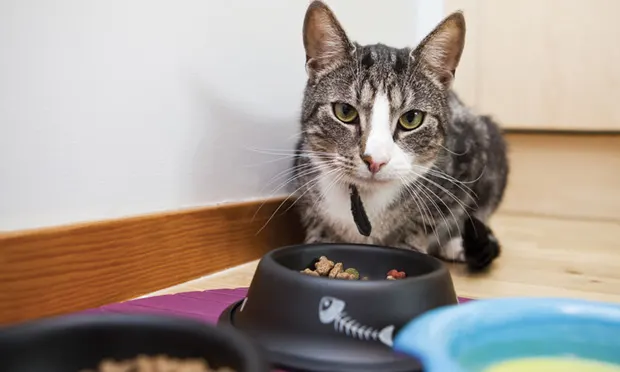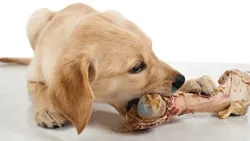Unconventional Diets

You have asked…How should I advise clients who inquire about trendy and raw diets?
The expert says…
Clients may choose to feed unconventional diets (eg, home-prepared, raw, vegetarian) for multiple reasons, including having negative feelings about commercial pet foods and positive ideas about alternative diets. Negative beliefs include concerns or misconceptions about ingredients (eg, fillers, by-products, roadkill, carbohydrates) and toxicities. Other clients may prefer to feed so-called “natural” (eg, what a wild canid or felid would eat, not containing synthetic ingredients) or raw foods, to prepare food for their pet, or to avoid triggering a real or suspected food intolerance or allergy.
Related Article: Advising Clients Who Feed Raw Diets to Pets
Clients may prefer to feed so-called “natural” or raw foods, to prepare food for their pet, or to avoid triggering a real or suspected food intolerance or allergy.
Ingredients in Commercial Foods
Pet foods often contain by-products (ie, secondary products) from human-food processing. These include offal (ie, organ meats) and parts that are nutritious but may be unappealing to humans, at times dependent on cultural or religious beliefs. For example, stomach or intestines may be included in pet food, and although these may be considered undesirable in some cultures, they are regularly consumed by humans in others. These products are often nutritious and result in good use of the carcass. Commercial diets may also contain antioxidant preservatives to prevent nutrient degradation and fat rancidification. Some contain coloring to make food more visually appealing to clients; this coloring is the same as that added to processed human food and is generally considered safe.
There is misconception that fillers, such as sawdust or other indigestible or nutrient-poor products, are included in commercial pet foods. However, pet foods do contain fiber (ie, indigestible ingredients), which serves many functions (eg, as probiotics for bacteria, to promote colonocyte health). Otherwise, ingredients in commercial diets typically have nutritional function.
Related Article: Homemade Diets
The concept that roadkill or dead pets are included in U.S. commercial diets is unfounded. On the other hand, toxins (eg, melamine) that can be found in pet foods resulted in a recall of many pet products in 2007.1 This incident exemplifies adulteration of a food product with a previously unknown toxin and as such would have been nearly impossible to predict. The industry took action during the recall, and the FDA has improved reporting of suspected contaminated food ingredients in response.
Perceived Benefits of Natural or Vegetarian Diets

Feeding dogs a diet similar to that of wild dogs or wolves (ie, low in grains or carbohydrates) has a popular following. Some clients opt to feed bones and raw foods, thought to be similar to a wolf eating a carcass or a cat catching prey. Clients should be reminded that dogs have been domesticated over the past 10,000 to 15,000 years, during which time their diet involved greater consumption of grains. Their genetic makeup evolved to accommodate this increase in dietary carbohydrates, and today dogs are genetically dissimilar to wolves in several key genes that involve starch digestion and glucose uptake.2 Many other metabolic traits were unaffected by domestication, and dogs as well as cats select a rather low-carbohydrate diet by choice, although both species can digest carbohydrates. Cats are obligate carnivores, requiring higher protein (generally meat, fish, or poultry) levels than do dogs.
Safety of a Raw Diet
Clients may be misinformed about the safety of raw diets. Studies on bacterial contamination of raw foods found that 20% to 35% of raw poultry and 80% of raw food diets for dogs tested positive for Salmonella spp, and 30% of stool samples from dogs fed these diets were positive for Salmonella spp.4 Raw food diets also have tested positive for Escherichia coli and Yersinia enterocolitica.4 Some otherwise healthy dogs may be able to cope with ingestion of these bacteria, but very young, old, or immunocompromised dogs may not. Furthermore, their feces can contaminate the environment, posing a risk to humans and other animals.
The close proximity of pets to human beings is an important zoonotic concern, and small children, the elderly, and the immunocompromised could become desperately ill secondary to exposure to pathogens that can be found in raw meat.
Parasites that may be present in raw meat include Echinococcus spp, Neospora caninum, Sarcocystis spp, Toxocara canis, Toxoplasma gondii, and Taenia spp.4,6,7 When handling raw food, the preparer must practice scrupulous hygiene, washing all surfaces and hands before touching anything or anyone else.
Bones: Dental Health & Safety Hazards

Some advocates of feeding bones to dogs claim that bones are beneficial for their oral and dental health. A study in African wild dogs found that they had dental diseases similar to those of domestic dogs8; many of the wild dogs had periodontitis without signs of dental tartar, so although their teeth may have appeared cleaner, their gums were not necessarily healthier. Studies of large wild cats also have shown feline odontoclastic resorptive lesions similar to those found in domestic cats.9
A bone large enough that it cannot be chewed into pieces is unlikely to cause GI obstruction; however, bone chewing is a frequent cause of fractured teeth. Smaller or splintered bones are at risk for obstructing the esophagus, stomach, or intestines. There is a conception that feeding raw bones may be safer than feeding cooked bones, although there is no evidence for or against this concept. Raw bones can carry the same inherent risks for pathogen contamination as does consumption of raw meat. Furthermore, bones that become stuck in the stomachor intestine may perforate the gut, potentially causing fatal peritonitis.
MARJORIE L. CHANDLER, DVM, MS, MANZCVSc, DACVN, DACVIM, DECVIM-CA, MRCVS, is small animal nutrition consultant and honorary internal medicine and clinical nutrition lecturer at Royal Dick School of Veterinary Studies, Edinburgh, Scotland. Dr. Chandler cochairs the WSAVA Global Nutrition Committee. Her interests include canine and feline clinical nutrition and internal medicine, particularly gastroenterology. She has lectured nationally and internationally and supports clinical nutrition education. Dr. Chandler earned her DVM at Colorado State University.